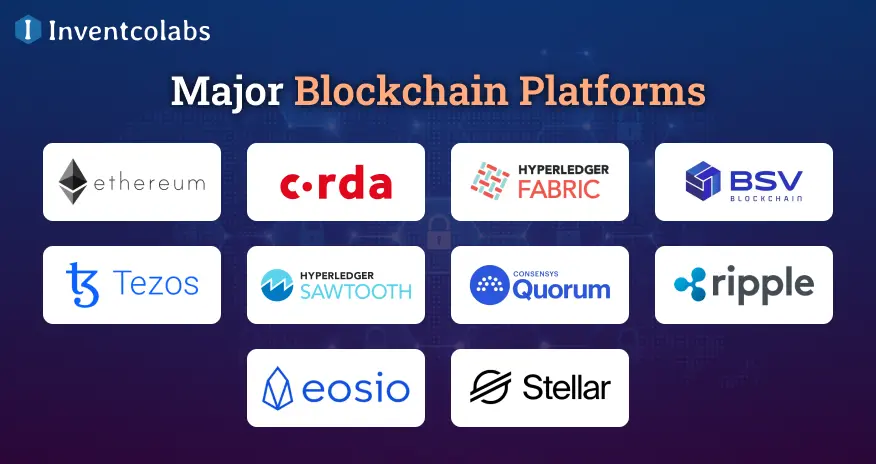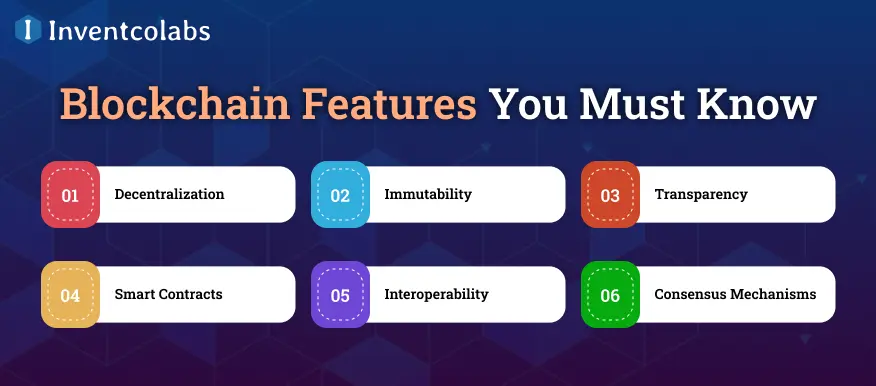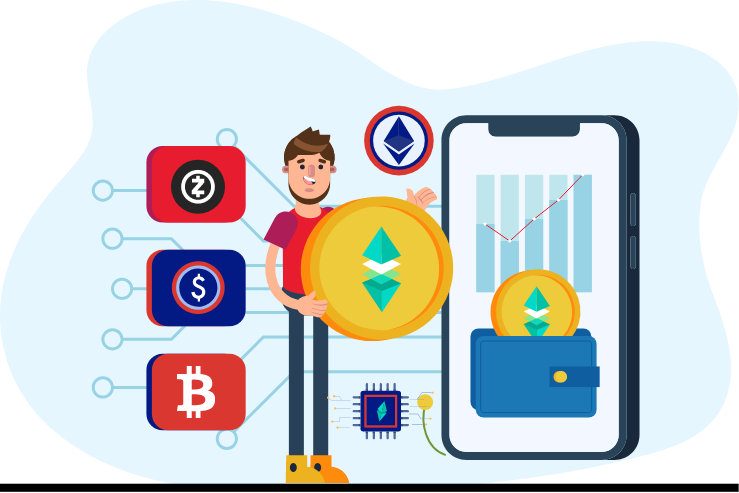Blockchain technology came into existence with the popularity of Bitcoin and has since grown into an all-encompassing and powerful technology in many sectors. Industries such as supply chain, logistics, healthcare, and finance have embraced blockchain technology to improve transparency and simplify business processes. Security, immutability, and decentralization are among the primary factors that have led to the rise of blockchain’s popularity.
Suppose you are enthralled by the potential for transformation offered by blockchain technology and want to tap its potential for success. In that case, the first step is to choose the appropriate blockchain development system. With a myriad of platforms to choose from, this choice can be a difficult one.
If you’re having trouble with this issue, you’re not alone. This blog is your reference, providing information on the best web3 dApp blockchain app development services platforms for 2025, which will allow you to build secure and efficient blockchain-based applications.
Process of Building a Decentralized App

After you’ve learned the basics of web3 dapp development and blockchain technology, now is the time to investigate the most important phases that determine the process from concept to app deployment.
>Define the Purpose, Market Research, and Project Specifications
Before constructing a decentralized application, it is essential to determine the app’s objective, which requires exhaustive market research and precise specification of the project.
This phase is more complex than conventional app development because it requires more involvement with the client’s goals and a deeper understanding of specific blockchain market dynamics.
The ability to customize strategy, which is the hallmark of bespoke software, is crucial in this case. Developers need to identify and meet the customer’s requirements and ensure that the dApp meets and exceeds market expectations. This provides a precise development plan that sets the stage for an app designed to meet user and market needs.
>Choosing the Right Technology
A thorough study of blockchain platforms is crucial since each has unique features and capabilities that can be used for various decentralized applications. Ethereum is a good example. It is popular due to its robust and innovative contract features and broad developer support, which makes it a desired choice for a wide range of decentralized apps.
Alongside choosing the best blockchain, the proper tooling and development frameworks are essential. Tools such as Truffle for Ethereum provide an environment for blockchain app development, a testing framework, and pipelines for assets, which speed up the process.
It is crucial that the platform chosen matches the team’s programming skills, whether in Solidity, Serpent, or other blockchain-specific languages, to avoid problems and maximize the team’s strengths.
>Smart Contract Development and Security Best Practices
The development of smart contracts requires careful specifications of requirements as well as the selection of suitable technology and languages for programming. Aligning with accepted coding standards and best practices is crucial to protect operations and the smart contract’s integrity.
Furthermore, thorough security audits and testing can help you find weaknesses early and effectively reduce risk. Implementing these methods improves the performance and reliability of dApps and helps protect them from ever-changing security threats.
>Front-End and User Interface Considerations for DApps
Designing the front ends of decentralized applications demands a focus on user-friendly interfaces, which encourage ease of navigation and participation.
Using modern frameworks such as React or Angular, developers can build interactive, fluid interfaces that allow interaction with blockchain-related functions. These frameworks facilitate using libraries such as Ethers.js, which are essential for connecting users’ interfaces to smart contracts based on blockchain networks.
Explore More: How to Develop a Blockchain App: Tech and Business Guide 2024
>Integration of DApps into Existing Business Systems
Integrating dApps seamlessly into existing business systems poses distinct challenges and offers substantial benefits. It extends blockchain’s unique capabilities into conventional business processes, increasing security, transparency, and efficiency.
To accomplish this, developers need to ensure that their dApps can communicate with the existing IT infrastructures using specific APIs and middleware. This allows for seamless information exchange between blockchain and traditional platforms while ensuring operational continuity and leveraging the advantages of both technologies.
>Integrate Backend Functionality
To allow a decentralized application to work effectively, the user-friendly front end needs to be supported by a solid backend infrastructure. This is vital not only to ensure the smooth operation and the scalability application, but also to ensure high-end security and data integrity.
Integrating the front end with smart contracts secures the connection and keeps the system decentralized while providing secure and reliable transaction and data storage.
>Post-Launch Maintenance and Support
After the app’s launch, developers need to continuously examine and improve the app’s performance while addressing any issues that arise with quick updates. Regular security audits are vital, helping to spot weaknesses and minimize them in an ever-changing digital threat landscape.
This proactive approach ensures that the dapp development remains secure and functional and allows it to adapt to changes in blockchain technology and users’ expectations. Maintaining the dApp current and being able to meet new challenges is essential to ensuring users’ trust and efficiency in a dynamic blockchain world.
Major Blockchain Platforms
 Blockchain functions as an indestructible ledger that permits the non centralized processing of transactions. At present, you are thinking about the most effective blockchains that can be utilized. The most popular blockchain platforms currently in use are listed below.
Blockchain functions as an indestructible ledger that permits the non centralized processing of transactions. At present, you are thinking about the most effective blockchains that can be utilized. The most popular blockchain platforms currently in use are listed below.
>Ethereum
One of the earliest cryptocurrency platforms, blockchain, is Ethereum. It was created in 2013 by a Canadian-Russian programmer known as Vitalk Buterin. Ethereum is a free, open-source distributed computing system that utilizes blockchain technology and also supports smart contracts.
As one of the top blockchains, Ethereum enhances Bitcoin and utilizes the technology of virtual machines (Ethereum Virtual Machine) to allow the application of smart contracts or custom business logic to develop new applications. The program’s operation gives users Ether or virtual money to encourage them. Ethereum is the Ethereum community that has also shifted to the more efficient Proof of Stake (PoS) consensus mechanism, which differs from a Proof of Works (PoW) method of consensus.
Read More: How To Get Started With Initial Coin Offering (ICO) Development?
>Corda
The Corda platform, which records and processes financial agreements, uses distributed ledger technology to achieve the objectives outlined in this piece. The Corda platform is compliant with Clack Bakshi, Clack, and Braine’s definition of smart contracts by implementing their. To ensure that the financial agreements made on the platform are solidly rooted in law, that they can be enforced, and that we know the right path to follow in the event of confusion, ambiguity, or conflicts, The smart contract connects business logic as well as business information to legal texts.
Corda is designed to meet regulatory requirements in financial institutions. While it does not have the architectural features that render conventional blockchains incompatible with numerous finance applications, it is strongly dependent on blockchain systems.
>Hyperledger Fabric
The Hyperledger community is a group effort that focuses on developing cross-industry blockchain technology. It has developed and is maintaining Hyperledger Fabric, an open-source distributed ledger software. It’s listed among the top ten best blockchains and provides a broad ecosystem of parts that can be incorporated into a modular framework. The Linux Foundation backs it. It is an excellent choice for using closed blockchains, increasing security and speed.
The blockchain-based implementation with a mission known as Hyperledger Fabric was created to serve as a platform that can be used to build blockchain-based applications in various sectors. Its modular structure allows plug-and-play integration for components like membership and consensus services. It utilizes containers to enable smart contracts that form the basis of the system’s application logic.
>BSV Blockchain
BSV Blockchain BSV Blockchain is committed to the original Bitcoin design developed by Satoshi Nakamoto, the creator of the Bitcoin white paper. After completely restoring an original Bitcoin protocol, The BSV Blockchain has unlocked its capacity for unlimited scaling. It’s the first public blockchain capable of unlimited scaling in the foundation layer.
Presently, the BSV Blockchain processes 4GB of data blocks, which can handle between 50,000 and 100,000 transactions every second. It is also among its most reliable and low transaction costs, which is $0.000015 for every transaction. This makes the BSV Blockchain capable of handling large amounts of data and immediately completing an enormous volume of transactions concurrently without worrying about network latency or increased costs.
Explore More: A Complete Guide To NFT Marketplace Development
>Tezos
Tezos is on the list of “the best blockchains” and features cutting-edge technology that surpasses the more well-known ones in several fields. The software used to implement Tezos has multiple layers.
Smart contract technology is integrated into the economy protocol. It has a unique “Proof-of-Stake” consensus process and serves as a decentralized platform for running smart contracts. It uses formal techniques to enhance security. It can also modify its own consensus algorithm (and more) via a voting system.
>Hyperledger Sawtooth
A framework to create distributed ledgers suitable for enterprise is known as Sawtooth. It was developed to be secure, flexible, and modular at the forefront of our minds. Sawtooth’s design provides the fundamental elements to create one of the most reliable blockchain platforms. It allows for decentralized record-keeping of transactions, aided by the smart contract layer, which handles transactions’ content and storage.
Sawtooth is designed with an interface for modular consensus and a modular transaction processing framework that supports diverse threat models, deployment scenarios, and intelligent contract language. A gossip network and cryptographically linked chain of transaction blocks are the basis of Sawtooth’s conventional blockchain.
>ConsenSys Quorum
ConsenSys Quorum’s inclusion among the top blockchains allows companies to utilize Ethereum in high-value blockchain apps. With the assistance of the Ethereum-based Distributed ledger Quorum, an authorized blockchain network can be created that will allow for private transactions.
With a particular focus on financial application cases, J.P. Morgan Chase first developed an open-source project called Quorum. ConsenSys recently purchased. To meet the requirements of the market, Quorum was added to the extensive community of permissioned blockchains Perform smart contract operations as well as private transactions. Offer a flexible and expressive control of network permissions; use various consensus algorithms plug-and-play.
>Ripple
The payment system and the Ripple network were developed by Ryan Fugger, David Schwartz, and Arthur Britto. To facilitate “secure, immediate, and almost free global financial transactions,” it was designed and released in 2012. Many institutions across the globe use Ripple as a base for their settlement systems—ripple systems as the base of their settlement networks.
In contrast, bitcoin relies on blockchain ledgers. Transactions are verified via network consensus instead of mining. It is an electronic record of digital money. The purpose of Ripple’s Ripple system, one of the best blockchains, was to help make Bitcoin more independent of central exchanges, consume less power, and perform transactions much quicker than Bitcoin. Ripple Transaction Protocol (RTXP) Ripple Transaction Protocol (RTXP) allows money to be transferred immediately and directly between two people.
Explore More: What is Web 3.0 and How it will Transform our Lives?
>EOSIO
With the assistance of the open-source, free blockchain technology called EOSIO Business, programmers and owners can create, launch, deploy, and utilize efficient blockchain applications. It offers developers a variety of instruments and sources, allowing the possibility of scaling up, and is fast, agile, flexible, and highly adaptable.
Due to the C++ base on which it was built, its “very flexible” environment may help both public and private networks.EOS coin is the name used to describe the blockchain platform and its native token, which are both part of the EOSIO ecosystem.EOS offers all the essential features that allow individuals and companies to create applications based on blockchain, similar to web-based applications. It will enable security-grade authorization, accessibility, control of data hosting, permissions, and internet-to-dApp connectivity.
>Stellar
Stellar is a cryptocurrency-based payment system that connects people and financial institutions to offer extremely affordable, lightning-fast international money transactions. Stellar Development Foundation published Stellar in April 2015, although McCaleb and Kim were the first to conceptualize it in 2014. A distributed ledger that can be used to transfer digital currency is known as the Stellar blockchain.
It is among the top blockchains that act as transparent, open records. Stellar stores the particulars of each transaction within Stellar, and the ledger is available to anyone connected to the network. Stellar Lumens, also called XLM, is Stellar’s primary token. Soroban is now available on the blockchain to simplify creating and installing Stellar smart contracts (SSC). The consensus technique the Stellar blockchain utilizes is faster, less costly, and more energy-efficient than Bitcoin.
Blockchain Features You Must Know

Its many features fill the gaps and attract various blockchain-related applications in the enterprise space. Here are a few of the most popular blockchain-related features you should know.
>Decentralization
In a corporate setting, it is a common belief that all compliance and communications should be handled centrally. Blockchain app development company could create a tamper-proof system by incorporating the decentralization mechanism, also known as the Blockchain of Things, into the business communications networks and compliance. This allows businesses to function in a safe system that is not susceptible to hacking.
>Immutability
Blockchain is based on an immutability mechanism, meaning it’s impossible to change the information that goes to the block, making accuracy and accuracy paramount.
In the traditional model, quality is an issue of many shifts and turns, which can lead to not only a delay in delivery times but also a result that isn’t a guarantee of quality or conformity with what was originally demanded.
However, if the company is under pressure to keep the data locked into systems, the likelihood of data completion and quality maintenance increases automatically.
>Transparency
Blockchain’s ability to provide transparency in everything results in introducing a new approach to how employees and other stakeholders behave in business. This transparency feature is transforming the future of transactions.
Blockchain’s inherent transparency changes the conventional business environment by making every transaction inexplicably traceable and immutable. This transparency increases accountability for employees and other stakeholders alike. Being aware that their actions are recorded increases their sense of responsibility, lessening the possibility of fraudulent or unethical conduct.
Furthermore, blockchain’s transparency increases confidence for all parties involved since they can verify the legitimacy of every transaction in real-time. The distributed and decentralized ledger system ensures that no single entity can alter or alter records, thereby promoting the notion of sharing accountability.
Read More: How To Develop A High-Performing Blockchain App?
>Smart Contracts
Self-executing contracts with predefined conditions and terms are called smart contracts. Blockchain-based automated contracts offer numerous advantages. They boost efficiency and reduce operating costs by streamlining processes and eradicating the need for intermediaries.
By automatizing processes, Smart contracts decrease the chance of mistakes and disputes while also increasing the speed and accuracy of transactions. They facilitate a smooth and transparent contracting environment by increasing the duration of a contract. Smart contracts are an innovative innovation in contract administration, providing an uncentralized, secure, and efficient method for online contracts.
>Interoperability
The interoperability feature within blockchain refers to the system’s capability to interact seamlessly with other blockchain systems and networks. This feature allows the exchange of information, collaboration, and efficient communication between different systems and organizations. Interoperability permits blockchain systems and networks to work together and improves the exchange of data and efficiency in the use of resources.
It plays an essential role in dissolving silos and allowing for an interconnected and more collaborative digital ecosystem. Interoperability will enable organizations to use several platforms’ strengths, providing an easier approach to sharing data and communications throughout the entire digital ecosystem. This creates an efficient, scalable, collaborative working environment across various blockchain-related applications.
Explore More: How To Create A Stablecoin On Ethereum?
>Consensus Mechanisms
Blockchain consensus mechanisms allow the network’s nodes to decide if an exchange is valid or not. These mechanisms are crucial to protecting the integrity of the blockchain since they ensure that every member is able to keep reliable, consistent track of each transaction. Blockchain networks provide a secure environment by stopping fraudulent transactions such as double-spending via consensus-building.
Consensus mechanisms are helpful since they create the commonality of all nodes, which increases the reliability and mutability of distributed ledgers. Different consensus algorithms, like Proof of Work (PoW) and Proof of Stake (PoS), offer distinct ways of finding a consensus that meets different blockchain networks’ specific needs and goals. We will continue to examine the need for a reliable, planned, well-designed enterprise blockchain system.
Conclusion
In conclusion, blockchain technology constantly evolves, and new applications are continually being developed. Identifying the blockchain-related tools that will be most well-known in 2025 is difficult. However, some of the most well-known contenders could be Hyperledger Fabric, Ethereum, Solidity, Embark, and Corda.
Each tool has distinct characteristics and capabilities. The best option for you will depend on your project’s particular requirements. It doesn’t matter if you’re an experienced developer looking to develop decentralized applications.
If the bank wants to boost the efficiency of its payment processing or the company wants to improve its supply chain management, there’s an application that utilizes blockchain technology to aid in achieving your goals. As the blockchain technology industry grows and develops, it is vital to stay current on modern tools and technology to ensure you remain active and profit from the many opportunities this exciting field provides.





